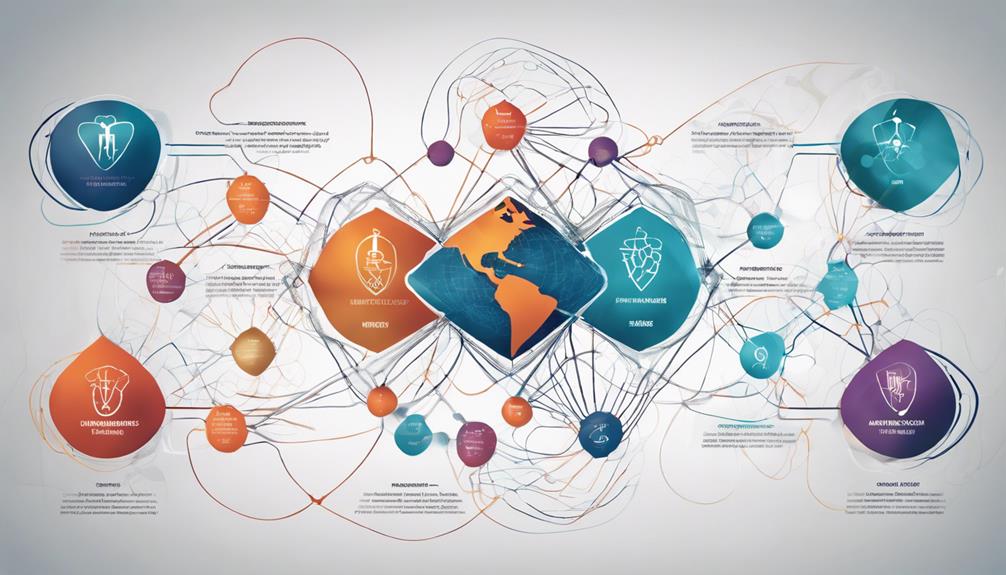Horizontal Mergers in the Healthcare Sector

Horizontal mergers in the healthcare industry are increasingly common as companies aim to improve their competitive position, reduce competition in the market, and take advantage of economies of scale. By joining forces with similar organizations, companies can streamline their operations, increase their bargaining power, and enhance the coordination of patient care.
Regulatory authorities closely monitor these mergers to prevent any negative impacts on competition, such as higher prices and limited patient access. While consolidation can lead to positive outcomes, it's important to recognize that it may also have adverse effects on communities by shutting down facilities and influencing the quality of care provided.
As the healthcare sector continues to evolve, understanding the intricacies of horizontal mergers is crucial for navigating the changing landscape. It's essential for organizations looking to merge to carefully consider the potential benefits and drawbacks, as well as the regulatory scrutiny they may face.
By staying informed and being aware of the implications of such mergers, companies can make more informed decisions that benefit both their operations and the communities they serve.
Key Takeaways
Horizontal mergers in the healthcare sector focus on combining companies that operate in the same market segment. The goal is to strengthen their market position by reducing competition and expanding their range of services. This can lead to increased efficiency and improved patient care within the industry.
Healthcare consolidation offers various advantages, such as economies of scale, better coordination of care, increased bargaining power with suppliers, and streamlined operations. These benefits can ultimately result in improved quality of services and more cost-effective healthcare delivery for patients.
Regulatory authorities closely monitor healthcare mergers to prevent any negative impacts on competition, patient access to care, or the affordability of services. They aim to ensure that mergers do not lead to higher prices, reduced quality of care, or limited choices for consumers.
Local communities may be affected by horizontal mergers in healthcare through changes in the availability of facilities, alterations in the way care is provided, and shifts in the dynamics of negotiations with insurance companies. It is essential for stakeholders to consider the potential consequences of mergers on the accessibility and quality of healthcare in their communities.
Looking ahead, the healthcare industry is expected to see more vertical integration, cost-saving initiatives, and a greater focus on patient-centered care within value-based healthcare systems. These trends will likely shape the future landscape of healthcare mergers and acquisitions, impacting how services are delivered and experienced by patients.
Rationale for Horizontal Mergers
The primary reason for engaging in horizontal mergers in the healthcare industry is to strengthen our competitive position by reducing market competition and expanding our presence within the same market segment. When we acquire organizations operating in the same healthcare market as us, we effectively eliminate competition and increase our market share. This strategic decision enables us to offer a broader range of healthcare services to our patients while solidifying our position as a leader in the industry.
Horizontal mergers allow us to benefit from economies of scale and improve our operational efficiency by consolidating resources and streamlining processes. This results in enhanced value for both our patients and shareholders.
It's essential to conduct a thorough evaluation of the potential risks associated with acquiring new organizations, as any existing liabilities or challenges they may have could impact the overall value of the merged entity. However, when executed carefully, horizontal mergers enable us to reinforce our dominance in the healthcare market and deliver exceptional services to our communities.
Potential Benefits of Consolidation

Consolidation through horizontal mergers in the healthcare sector offers numerous compelling benefits. Economies of scale can be harnessed to reduce costs, improve patient care coordination, and strengthen our bargaining power with external parties.
Regulatory Scrutiny and Challenges

Horizontal mergers in healthcare undergo thorough regulatory scrutiny to ensure they don't harm competition and patient access to care. Federal and state antitrust agencies carefully analyze these mergers, focusing on their impact on market power, pricing, and the ability to provide quality care.
The review process examines potential anticompetitive effects such as reduced access to care from service line eliminations, limited price transparency leading to higher costs for consumers, constraints on patient choice and care options, and the risk of monopolistic behavior hindering innovation and quality.
This regulatory scrutiny is crucial to safeguard patient interests and maintain fair market practices in the healthcare industry. Upholding these standards helps create a balanced environment that maximizes the benefits of consolidation while also preserving competition and protecting consumer well-being.
Patient and Community Impacts

Horizontal mergers in the healthcare sector can significantly impact patients and their local communities. When healthcare organizations merge horizontally, competition can decrease, leading to higher prices and fewer care options for patients. This can result in the closure of redundant facilities, which can harm local economies and employment opportunities.
Patients may also experience changes in how care is delivered and the services available to them, potentially affecting their health outcomes and satisfaction.
After a merger, the combined entity may have increased market power, which could affect negotiations with insurers. This could result in higher costs for patients and payers. It's crucial to consider the effects of horizontal mergers on the health, access, and quality of care within a community.
As industry leaders, we must carefully balance the potential benefits and risks to ensure that patients' needs are prioritized.
Future Trends in Mergers

In the shifting landscape of healthcare, mergers are increasingly focusing on integrating services, reducing costs, and managing risk-based payment models.
Looking ahead, we can expect several significant trends to shape the industry:
Healthcare providers are likely to pursue more vertical integration by acquiring insurers and ancillary services. This strategy aims to streamline operations and enhance risk management capabilities.
To achieve anticipated cost savings, organizations will need to implement cost-cutting measures like coordinating clinical services and consolidating redundant facilities through mergers.
Horizontal mergers will prioritize integrating complementary services to optimize resource allocation and elevate patient experiences, signaling a shift towards a more patient-centric approach.
Future mergers will be heavily influenced by the need to navigate risk-based payment systems, promoting value-based care. This focus on managing population health and financial risk will be a key driver for organizations seeking to thrive in the evolving healthcare landscape.
Frequently Asked Questions
What Is a Horizontal Merger in Healthcare?
Horizontal mergers in healthcare involve the joining of two companies that operate in the same or similar areas of the industry. These mergers aim to improve patient access, streamline operations, and reduce costs by combining resources, expertise, and technology. By consolidating services and integrating workforce, organizations can enhance efficiency and quality of care.
Regulatory considerations play a crucial role in horizontal mergers in healthcare. Companies must navigate complex laws and regulations to ensure compliance and maintain high standards of patient care. By adhering to regulatory requirements, organizations can create a more seamless transition during the merger process and prevent any disruptions in service delivery.
In addition to regulatory considerations, data consolidation and technology harmonization are essential aspects of horizontal mergers in healthcare. By aligning data systems and integrating technology platforms, organizations can improve communication, coordination, and decision-making processes. This integration not only benefits patients through enhanced care coordination but also allows organizations to leverage data for performance improvement and innovation.
Furthermore, horizontal mergers in healthcare can lead to an expansion of geographic reach and drive innovation in the industry. By combining resources and expertise, organizations can explore new markets, offer a wider range of services, and invest in research and development. This expansion and innovation ultimately benefit patients by providing access to a broader range of healthcare services and treatments.
What Is an Example of Horizontal Integration in Healthcare?
Merging with other companies in the healthcare industry can help us strengthen our position in the market. This type of merger, known as horizontal integration, allows us to combine our resources with those of our competitors to become a larger and more influential player in the healthcare sector.
Through horizontal integration, we can expand our range of services by incorporating those offered by the companies we merge with. This can lead to a more comprehensive and diverse set of offerings for our patients, ultimately improving their overall healthcare experience.
Additionally, by joining forces with industry peers, we can benefit from cost-saving synergies. This means that by sharing resources and streamlining operations, we can reduce expenses and improve efficiency across the board.
Furthermore, horizontal integration can enhance our technological capabilities by combining the expertise and resources of multiple companies. This can drive innovation within our organization, allowing us to stay at the forefront of technological advancements in healthcare.
What Are Examples of Horizontal Mergers?
Horizontal mergers are common in industries like technology and telecommunications, where companies merge to expand their market share and streamline operations. These mergers involve companies that operate in the same industry and produce similar products or services. For example, when two telecommunications companies merge, they can combine their networks and resources to offer better services to their customers.
One well-known example of a horizontal merger is the merger between T-Mobile and Sprint in the telecommunications industry. This merger allowed the two companies to pool their resources and compete more effectively with larger competitors like Verizon and AT&T. It also enabled them to invest in new technologies like 5G networks, which would have been more challenging for each company to do on its own.
Horizontal mergers can lead to cost savings and efficiencies through economies of scale. By combining operations, companies can reduce duplicated functions and streamline their processes. This can result in lower costs for the merged entity, which can then be passed on to consumers in the form of lower prices or better services.
However, horizontal mergers also raise concerns about market concentration and potential antitrust issues. When companies in the same industry merge, they may reduce competition and have more power to control prices or limit choices for consumers. Regulators closely scrutinize these mergers to ensure that they do not harm competition or consumers.
What Is an Example of a Merger in Healthcare?
Summit Health's recent acquisition of Summit Medical Group and CityMD is a prime example of a horizontal merger in healthcare. This type of merger involves companies that are direct competitors in the same industry coming together to create a larger, more powerful entity.
Horizontal mergers like this one have the potential to improve patient outcomes by offering a wider range of services and expertise under one roof. By consolidating resources, these mergers can also create cost-saving opportunities that may be passed on to patients in the form of lower healthcare costs.
Furthermore, when companies merge horizontally, they can foster innovation potential by combining their research and development efforts. This can lead to the development of new treatments, technologies, and approaches to healthcare that may not have been possible for either company on its own.
While regulatory oversight and workforce integration are important considerations in any merger, when done thoughtfully and strategically, horizontal mergers in healthcare have the potential to bring about significant benefits for patients, providers, and the industry as a whole.
Conclusion
Horizontal mergers in the healthcare sector have been on the rise, with a significant number of these mergers taking place between 2010 and 2019. During this period, there were over 1,100 horizontal mergers in the healthcare industry, totaling $548 billion in value. These mergers involve companies that operate in the same or similar areas of the healthcare market coming together to form a single entity.
The main motivation behind horizontal mergers in healthcare is often to achieve operational efficiencies and gain more bargaining power. By combining resources and expertise, merging companies hope to streamline their operations and improve their ability to negotiate with suppliers and payers. However, this consolidation also raises concerns about reduced competition and potentially higher prices for patients.
As regulatory scrutiny of healthcare mergers tightens, organizations in the sector need to approach these deals with caution. It's crucial for healthcare companies to carefully navigate the complexities of mergers and acquisitions to ensure that they're creating value for their communities.
This involves conducting thorough due diligence, engaging with regulators early in the process, and developing a clear strategy for post-merger integration.





